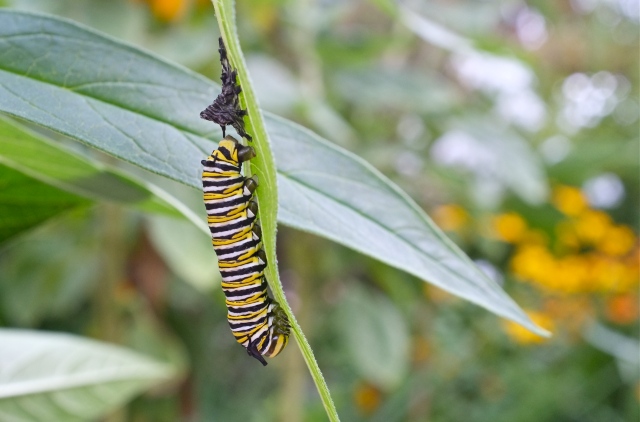Turn up the volume to hear the caterpillars noshing away 🙂
Monarch caterpillars use their sense of smell, touch, and taste to navigate from milkweed leaf to milkweed leaf. The hungry caterpillar tears milkweed into bite-sized pieces with its mandibles.
When devouring the foliage of a milkweed plant, what happens when a caterpillar encounters another of its own kind on the same leaf? Will it fight to defend its food? Typically, the caterpillar responds by pulling away and repositioning itself on the leaf, barely missing a beat.
A recent article in the NYTimes, “Don’t Get Between a Caterpillar and Its Milkweed,” reviews the paper, “Aggression Is Induced by Resource Limitation in the Monarch Caterpillar,” authored by Collie, Granola, Brown, and Keene. Monarchs raised in a laboratory were given varying amounts of milkweed. Monarch caterpillars, they claim, lunge aggressively towards each other in greater and greater frequency as their milkweed supply was decreased.
In all the years I have been filming Monarch butterflies and caterpillars in gardens and in the wild, I would never have thought to describe the caterpillar’s behavior as fighting, aggressive, hangry, lunging, or head butting.
Monarch caterpillars use their sense of touch smell, and taste to eat their way from leaf to leaf. When another of its own kind is encountered on the same milkweed leaf, Monarchs in the wild pull back and reposition themselves on the leaf, barely missing a beat.
Monarch caterpillars do this same “pulling back” when brushed up against. I think it is more of a sensory response because caterpillars can barely see. Their simple eyes, called ocelli, only differentiate light from dark and cannot form an image. When a group are feeding in the same area, their behavior upon encountering one of their own kind is more characteristic of bumping into each other rather than aggressively defending their territory.
Towards the end of the summer, when milkweed leaves may be in shorter supply, caterpillars in the wild will eat the seedpods and even the stems of milkweed plants rather than aggressively battle for food.
Monarch caterpillars do not have the ability to “fight.” Their greatest defense against predators is the the caterpillar’s bright color and striped patterning, warning birds of its toxicity.
Every species of caterpillar has evolved with its own species-specific form of visual self-defense, visual against birds that is. Camouflage, mimicry, pokey spikes and spines, or brilliant colors and patterning are examples of defensive visual cues. Some caterpillars look like they are a sploge of bird poop (discouraging an attack from an avian predator) and some like leaves on a tree.
Swallowtail caterpillars have evolved with an osmeterium, a sort of forked appendage that everts when the creature feels threatened. The osmeterium resembles a snake’s tongue, also discouraging avian predation.
Black Swallowtail orange osmeterium
Some caterpillars are thought to be cannibalistic however, I am not sure cannibalism is the correct word because that suggests the act of willfully eating one of their own kind.

 Pipevine Swallowtail eggs and caterpillars
Pipevine Swallowtail eggs and caterpillars
Pipevine Swallowtail eggs are deposited by the female butterfly in clusters and the early instars continue to feed in a group.
Around the third or fourth instar, they will devour each other if not enough food for is available. Caterpillars taste like the leaves they eat. Doesn’t it seem natural that if a caterpillar cannot see what it is eating, it would simply eat whatever is in front of it if the ‘whatever’ tasted of its food plant? I wouldn’t call this aggressive behavior, the cat is simply using its sense of taste, smell and touch to locate readily available food.
Aggression Is Induced by Resource Limitation in the Monarch Caterpillar
Highlights
Monarch caterpillars display stereotyped aggressive behavior
Aggression is triggered by limited food availability
Aggression peaks during the late stages of caterpillar development
Summary
Food represents a limiting resource for the growth and developmental progression of many animal species. As a consequence, competition over food, space, or other resources can trigger territoriality and aggressive behavior. In the monarch butterfly, Danaus plexippus, caterpillars feed predominantly on milkweed, raising the possibility that access to milkweed is critical for growth and survival. Here, we characterize the role of food availability on aggression in monarch caterpillars and find that monarch caterpillars display stereotyped aggressive lunges that increase during development, peaking during the fourth and fifth instar stages. The number of lunges toward a conspecific caterpillar was significantly increased under conditions of low food availability, suggesting resource defense may trigger aggression. These findings establish monarch caterpillars as a model for investigating interactions between resource availability and aggressive behavior under ecologically relevant conditions and set the stage for future investigations into the neuroethology of aggression in this system.













